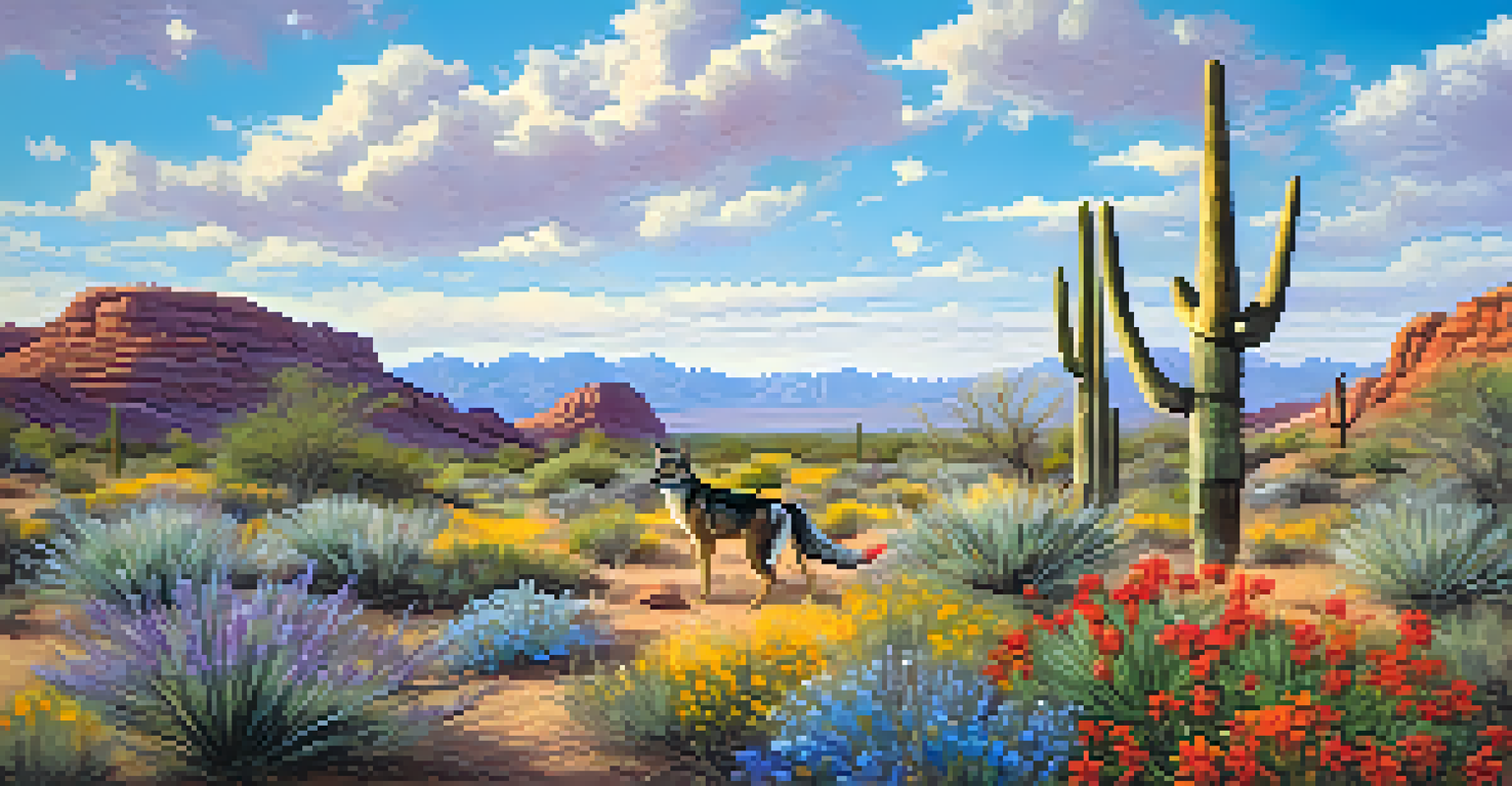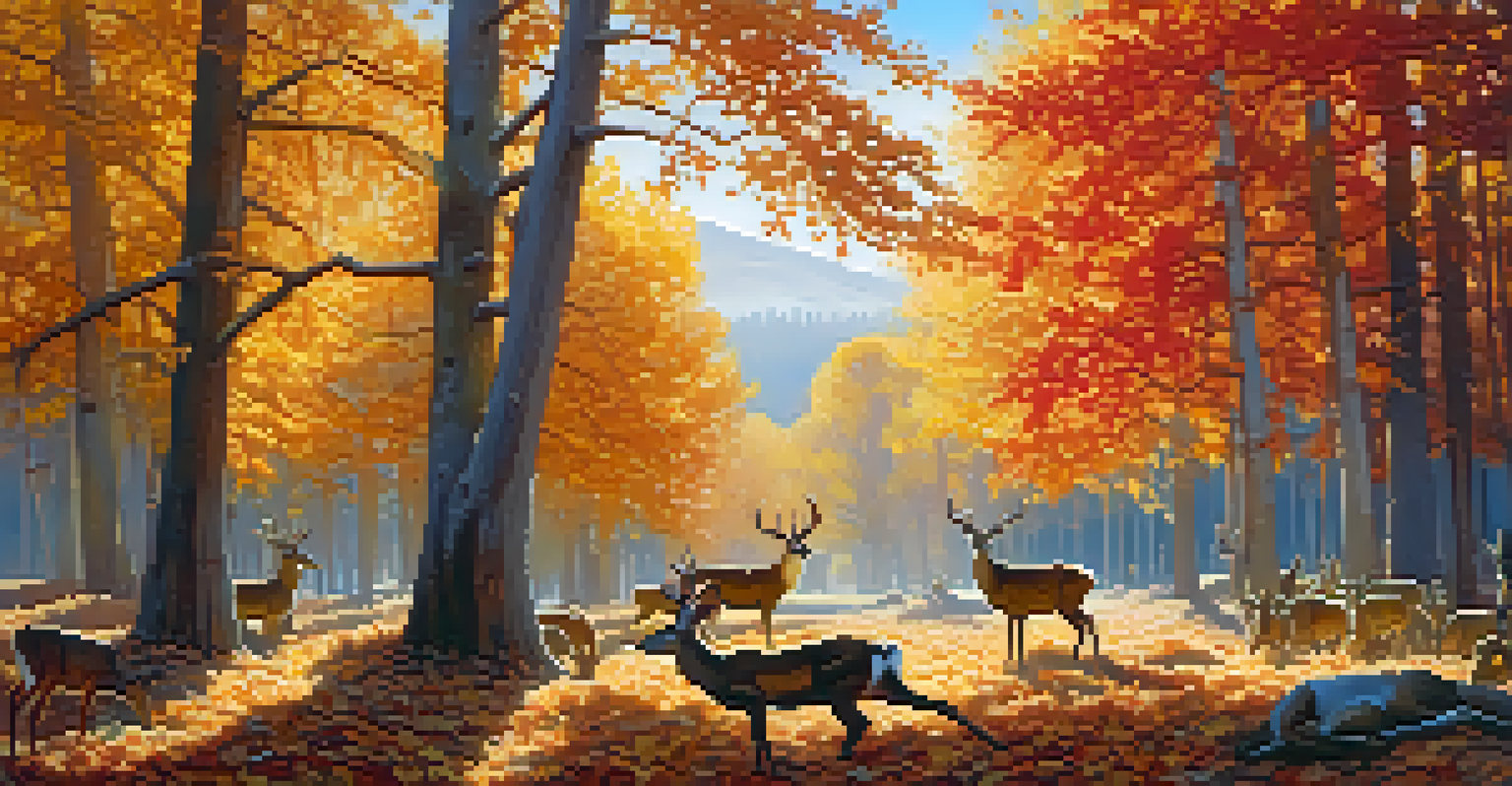Seasonal Wildlife Viewing: What to See in Arizona Year-Round

Introduction to Arizona's Diverse Wildlife
Arizona is a treasure trove of wildlife, boasting a stunning variety of species across its diverse landscapes. From the arid deserts to lush forests, each ecosystem supports unique animals that reflect the state's rich biodiversity. Whether you're an avid birdwatcher or a casual nature lover, there's something exciting to discover throughout the year.
In every walk with nature one receives far more than he seeks.
Understanding the seasonal patterns of wildlife can enhance your viewing experience. Different animals thrive during particular times of the year, making it essential to plan your outings accordingly. This guide will walk you through what to expect in each season and how to make the most of your wildlife encounters.
As you explore, remember that patience is key. Many animals are shy and elusive, often requiring a bit of quiet time to reveal themselves. So grab your binoculars and get ready for an adventure that connects you with nature in the heart of Arizona.
Winter Wonders: Viewing Wildlife in the Cold Months
Winter in Arizona might surprise you with its wildlife activity, especially in lower elevations. While many regions experience cool temperatures, the desert remains vibrant, offering opportunities to spot animals like coyotes and desert bighorn sheep. Additionally, migratory birds flock to the warmer areas, making this a prime time for birdwatching enthusiasts.

If you're heading to northern Arizona, keep an eye out for elk and mule deer as they roam through the snow-covered forests. National parks such as the Grand Canyon and Flagstaff showcase these majestic creatures against a stunning winter backdrop. Remember to dress warmly and bring your camera; the sights are truly breathtaking.
Experience Arizona's Seasonal Wildlife
Each season in Arizona offers unique wildlife viewing opportunities, from vibrant spring blooms to the serene beauty of winter.
Moreover, winter is a quieter time for wildlife, allowing for more intimate viewing experiences. With fewer crowds in popular areas, you may find yourself having a serene encounter with nature. So, bundle up and embrace the beauty of Arizona's winter wildlife!
Spring Awakening: Wildlife Activity in Bloom
As spring arrives, Arizona bursts with life, and wildlife viewing opportunities expand significantly. The warmer weather and blooming flora attract various species, making it an ideal time for spotting everything from colorful songbirds to playful mammals. The vibrant wildflower season adds a spectacular backdrop to your wildlife adventures.
The earth has music for those who listen.
Spring is also the time for animal courtship and nesting behaviors, providing a unique chance to witness these fascinating activities. Keep an eye out for courtship displays among birds, as they flaunt their plumage and songs to attract mates. This season is particularly rewarding for birdwatchers eager to see Arizona's feathered residents in action.
Additionally, many animals emerge from hibernation during this season, adding to the excitement. Whether hiking in the Sonoran Desert or exploring the forests of the Mogollon Rim, spring is a season of renewal and exploration in Arizona's wildlife world.
Summer Sights: Adapting Wildlife in the Heat
Summer in Arizona can be intense, but wildlife has adapted remarkably to thrive in the heat. Early mornings and late evenings are the best times to observe animals, as many seek shelter during the hottest parts of the day. This is when you might catch glimpses of elusive creatures like bobcats or javelinas.
Birdwatchers will delight in the sight of various species nesting and feeding their young. Look for hummingbirds flitting among the blooming cacti and vibrant orioles in the trees. The sights and sounds of summer create a dynamic atmosphere filled with life, making every outing an adventure.
Explore Diverse Wildlife Hotspots
Visiting various habitats like Saguaro National Park and the Grand Canyon allows you to experience the full spectrum of Arizona's wildlife.
However, it's crucial to stay hydrated and protect yourself from the sun while exploring. Bring plenty of water and wear sunscreen to ensure a safe and enjoyable experience. Despite the heat, Arizona's summer wildlife offers a unique and rewarding viewing opportunity.
Autumn Adventures: Viewing Wildlife in Cooler Weather
As fall arrives, temperatures begin to cool, and wildlife becomes more active, making it another excellent time for viewing. Animals prepare for winter by foraging for food, and this increased activity can lead to some memorable encounters. Keep an eye out for deer as they move through the changing foliage, showcasing their impressive antlers.
Bird migration also peaks during autumn, as many species make their way south for the winter. This is a fantastic opportunity to witness large flocks of birds, particularly in areas like the San Pedro River Valley. Bring your binoculars and enjoy the spectacle of nature's seasonal changes.
Fall colors add an extra layer of beauty to your wildlife excursions, turning Arizona's landscapes into a mosaic of reds, oranges, and yellows. Whether hiking through the forests or exploring the deserts, autumn is a season that enhances the overall wildlife viewing experience.
Unique Habitats: Exploring Arizona's Wildlife Hotspots
Arizona is home to a variety of habitats, each offering unique wildlife viewing opportunities. From the iconic Sonoran Desert to the towering pines of the San Francisco Peaks, each ecosystem supports different species. Visiting these hotspots allows you to experience the full spectrum of Arizona's wildlife throughout the year.
Some must-visit locations include Saguaro National Park, where you can see the majestic saguaro cactus alongside desert creatures. The Verde Valley offers lush riparian zones teeming with birds and other wildlife. Meanwhile, the Grand Canyon is not only a breathtaking sight but also a haven for various animals, including the elusive California condor.
Practice Ethical Wildlife Viewing
Respecting animals and their habitats is crucial for preserving Arizona’s ecosystems while enjoying wildlife encounters.
Exploring these habitats can be an enlightening experience, as you learn about the interconnectedness of ecosystems and their inhabitants. Guided tours or wildlife excursions can enhance your understanding and increase your chances of spotting elusive species. So, pack your bags and prepare for an unforgettable wildlife adventure!
Ethics of Wildlife Viewing: Respecting Nature
As you embark on your wildlife viewing adventures, it's essential to practice ethical behaviors that respect both animals and their habitats. Keeping a safe distance from wildlife not only protects you but also minimizes stress on the animals. Remember, getting too close can disrupt their natural behaviors and feeding patterns.
Always adhere to local guidelines and regulations when it comes to wildlife viewing. This includes staying on designated trails and not feeding the animals, as human food can be harmful. Consider carrying a pair of binoculars to enhance your viewing without encroaching on their space.

By practicing ethical wildlife viewing, you help preserve the beauty of Arizona's natural ecosystems for future generations. Each visit should contribute to a greater understanding and appreciation of wildlife, fostering a deeper connection to the natural world.
Preparing for Your Wildlife Viewing Experience
To make the most of your wildlife viewing experience, a bit of preparation goes a long way. Start by researching the best locations and times to see specific species throughout the year. Having a plan can significantly increase your chances of encountering wildlife, whether you're interested in birds, mammals, or reptiles.
Additionally, pack essential items like binoculars, a field guide, and a notebook to jot down your observations. A camera can also be a great addition, but keep in mind the importance of not disturbing the wildlife for the perfect shot. Being well-prepared ensures you have a fulfilling and enjoyable experience.
Lastly, consider joining local wildlife groups or guided tours to enhance your knowledge and connect with fellow nature enthusiasts. These experiences can provide valuable insights and tips for successful wildlife viewing, making your Arizona adventure even more memorable.